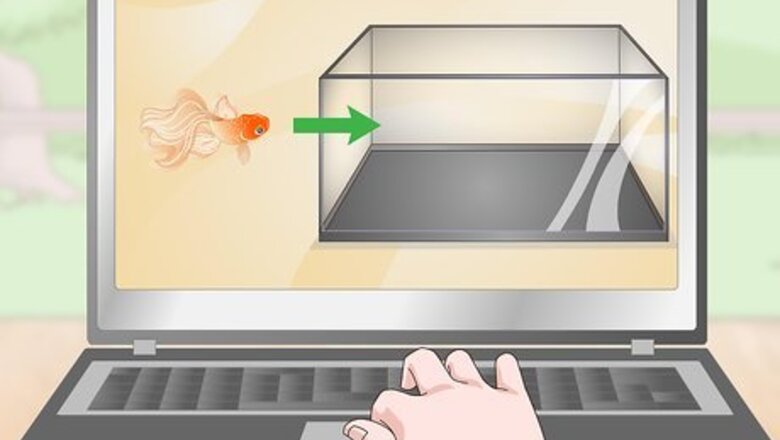
views
Maintaining a Coldwater Fish Tank
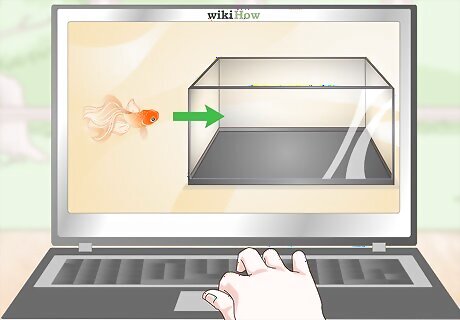
Research the needs of the species you plan to keep. Not all coldwater fish have the same requirements. Before you set up a habitat for the fish you plan to get, find out what they need in terms of space, food, and appropriate tankmates. For example, goldfish need lots of space (at least 30 gallons (110 L) of tank space for one common goldfish, with another 12 gallons (45 L) for each additional fish). They are herbivorous, so they need a plant-based diet. On the other hand, white cloud mountain minnows can live in schools of 8-10 in a 15 US gal (57 L) tank. These fish are carnivorous, so they need a mixture of flake and animal-based foods.
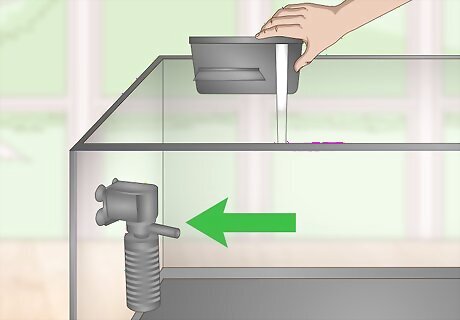
Purchase a power filter appropriate for your tank size. You will need a filter to keep your tank clean and your fish healthy. The filter can also help aerate the water and prevent stagnation. Check with a fish specialist at your local pet store to find out which filter will work best for your tank. The best filters combine chemical, mechanical, and biological filtration. These filters not only clean out solid waste and unwanted chemicals, but will also promote a healthy balance of bacteria in your aquarium. Some species of coldwater fish, such as goldfish, produce unusually high amounts of waste. If you keep goldfish or another messy species, good mechanical filtration is essential for the health of your fish.
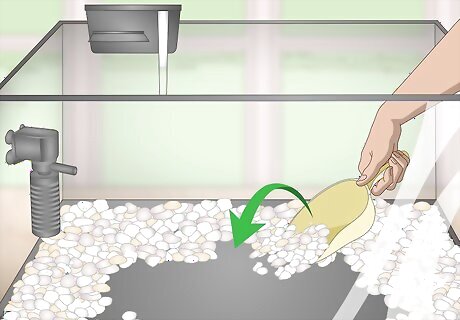
Add a gravel substrate to the tank. Choose gravel that is specifically sold for use in fish tanks, since gravel from your yard or driveway may be contaminated with chemicals that are hazardous for your fish. If you plan to keep bottom-dwelling fish, such as loaches, make sure the gravel you pick has smooth edges. Gravel that is too sharp can hurt your fish. In addition to making the tank look more natural and attractive, the substrate can also provide a good anchor for aquarium plants and other décor. The substrate also serves as a dwelling place for beneficial bacteria. If you prefer, you can use sand or a specially formulated soil substrate instead of gravel. Sand creates a very natural environment and is easy to clean, while soil is a good choice if you want to grow live plants in your tank.
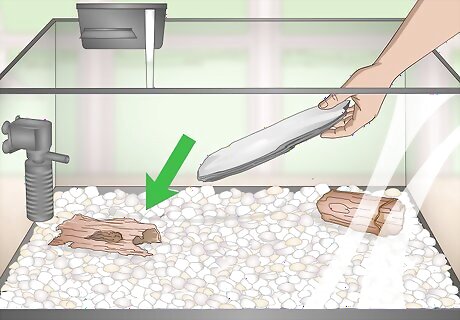
Put decorations in your aquarium. Decorations look pretty and offer your fish places to hide and interact with their environment. If you add rocks or other decorations, make sure they are free from sharp edges. Other options include artificial plants, hollow fish logs or caves, and pieces of driftwood. Make sure to choose decorations that are designed for use in fish tanks so that you do not introduce any hazardous chemicals to the tank. Rinse any artificial plants or other decorations in clean water before adding them to the tank.
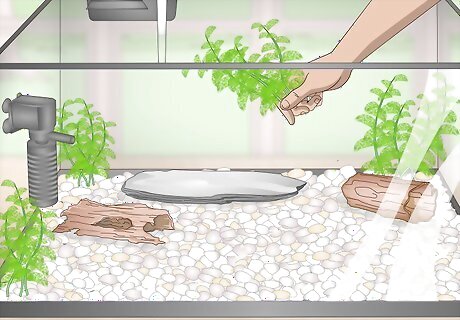
Add coldwater live plants for a more natural aquarium. Live plants look beautiful, offer places for your fish to hide, and help oxygenate the water in the tank. Some good plant choices for coldwater fish tanks include java moss, Cabomba, and water cabbage. Marimo moss balls (actually a type of algae) are also attractive and easy to keep. Keep in mind that some types of fish (such as goldfish) like to uproot and nibble on live plants. Make sure to select species that are safe for any plant-eating fish in your tank to eat. For example, if you have goldfish, you can safely keep plants such as duckweed, hornwort, or java fern.
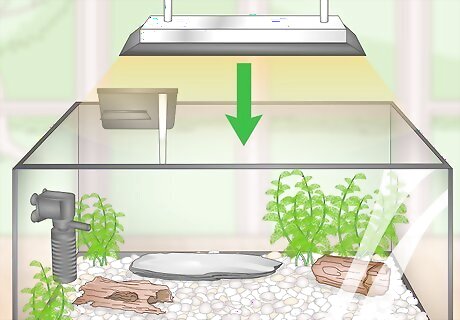
Light the tank with an artificial light source. Keep your coldwater tank out of direct sunlight, which can warm the water too much and cause algae in the tank to grow out of control. Instead, choose a gentle artificial light source, such as fluorescent or LED bulbs built into the lid of the tank. Keep the light on for only 8-10 hours during the day and turn it off overnight to simulate a natural day-night cycle. It may be helpful to get a light with a built-in timer.
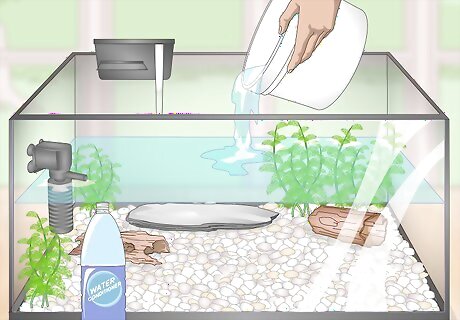
Fill the tank with clean, dechlorinated water. If you use tap water, you will need to dechlorinate it by using a water conditioner or allowing the water to sit in an open container for 24 hours. You can purchase a water testing kit at your local pet store or bring in a sample to make sure that your water is free from chemical contaminants and has a healthy pH balance for your fish. Most coldwater fish do best in water that has a pH of around 7. Research the needs of your fish to find out what specific pH range and water hardness levels are healthiest for them.
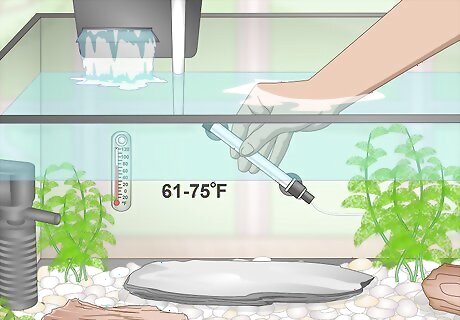
Keep your tank's temperature between 61–75 °F (16–24 °C). Unless you keep your home very warm or very cool, most coldwater fish do fine in a tank kept at room temperature. Put a thermometer in the tank to make sure that the water is staying within an acceptable temperature range, and keep the tank away from drafts and heat sources (such as space heaters or direct sunlight). If your tank tends to get too hot, you can purchase an aquarium chiller to maintain cooler temperatures. Aquarium chillers are typically much more expensive than heaters, with many models costing $200 USD or more.
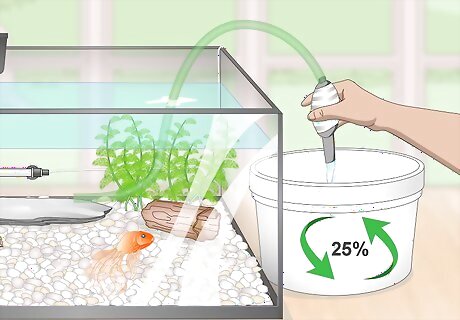
Change out 25% of the water in the tank once a week. Even with a filter installed, you will need to do regular partial water changes to maintain the health of your tank. Use a siphon to remove about ¼ of the water from the tank, then replace what you took out with clean, dechlorinated water. Try to add water with a similar temperature and pH level to the water you removed. You may need to adjust how frequently you change the water depending on the size of your tank and how many fish you have. For example, if you have 5-6 small fish in a 5.5 US gal (21 L) tank, you may need to change the water as frequently as every 3-4 days.
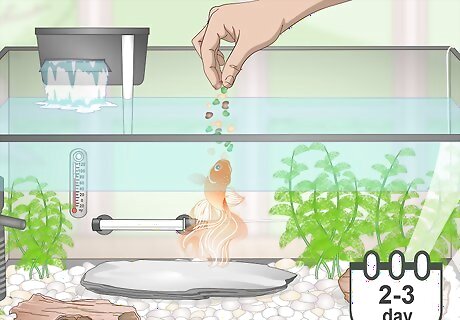
Give your fish 2-3 small meals daily. The appetites and dietary requirements of coldwater fish can vary quite a bit, so get familiar with the needs of the species you plan to keep. As a general rule, you should feed your fish no more food than they can finish in 4-5 minutes. Coldwater fish can be herbivores, carnivores, or omnivores, so check to make sure you are getting the right kind of food for your species of fish. If you have more than one species of fish together in a tank, you may need to get a variety of foods to meet all their needs.
Keeping Coldwater Fish in a Pond
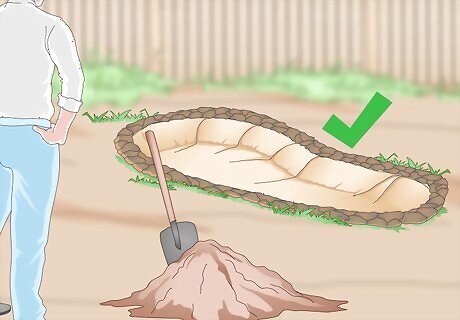
Build a pond that is the right size for your fish. Many species of coldwater fish thrive in garden ponds. The size of your pond will depend on the type and number of fish you plan to keep. Research the needs of your preferred type of fish before you build and stock your pond. For example, if you are keeping koi, you will need a pond that with a capacity of 150 gallons (570 L) per fish. For a goldfish pond, you'll need around 30 gallons (110 L) per fish. Ideally, your pond should be around 3–5 feet (0.91–1.52 m) deep, especially if you live in an area with freezing temperatures. This depth will help prevent the pond from freezing over. You can construct your pond from scratch or buy a pre-made pond form at a home or garden supply store. Consider hiring a landscaping professional if you don't feel comfortable building the pond yourself.
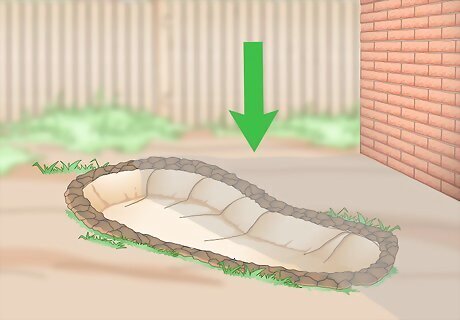
Place your pond in a partially shaded area. Coldwater fish may become overheated if their environment is exposed to direct sun for most of the day. Too much sunlight can also cause an overgrowth of algae in your pond. Look for a spot in your garden where your pond will get a good balance of light and shade throughout the day. If your pond gets no sunlight at all, your pond plants will not thrive and your fish may be sluggish. If you can't find a shady spot in your garden, you can partially shade the pond by placing plants, rocks, and other ornamentation around it.
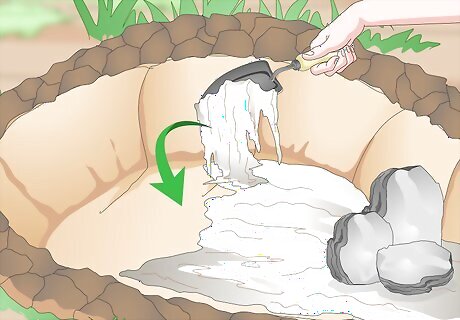
Add fish-safe substrate and décor to your pond. You can create a more attractive and enriching environment in your pond by adding rocks, decorations, and plants. Put in any large decorative objects first, then pour in some aquarium or fish pond sand as a substrate. The sand will help serve as an anchor for plants and décor. Be sure to use sand, rocks, and decorations that are sold for use in aquariums or fish ponds. Objects not designed for this use may have chemical contaminants that could harm your fish. If you add water plants to your pond, check first to see if they are safe for your fish to nibble.
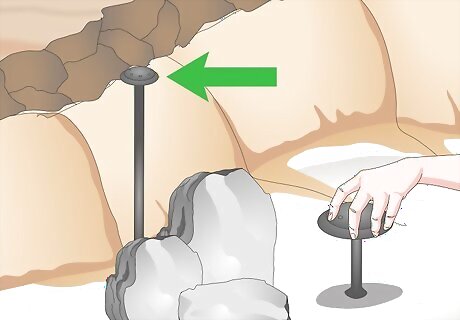
Use an aerator to keep the water cool and oxygenated. Air pumps can help keep your pond from stagnating or becoming too hot or cold. They also distribute oxygen through the water, allowing your fish to breathe. Buy a pump that is designed for the volume of your pond. You can buy a pond aeration pump online or at a garden supply store. For large ponds, you may need multiple pumps. Air stones and other aeration ornaments can help soften the flow of air and diffuse the air from your pump more effectively.
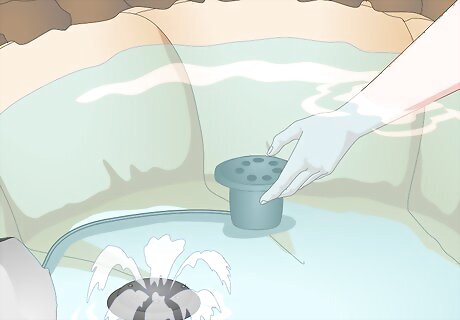
Buy a filter that is appropriate for the size of your pond. Just like an aquarium, a fish pond needs a filter to keep the water clean and healthy for your fish. This is especially important for species like goldfish, which produce large amounts of waste. Check the filter capacity to make sure it will work with the volume of your pond. You can buy a pond filter from a home or garden supply store, or build your own if you prefer.
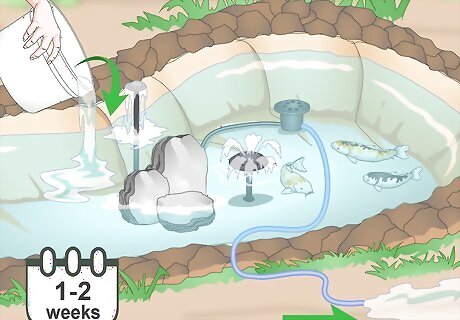
Do partial water changes every 1 to 2 weeks. Even with a filter, your pond water will quickly become dirty without regular water changes. Use a siphon to remove no more than 25% of the water from the pond. Replace what you remove with clean, dechlorinated water. When you refill the pond, try to use water that is roughly the same temperature and pH level as the water you removed.

Add cool water gradually if the pond overheats. If it's a hot day and you notice your fish gasping for air at the surface of the pond, you will need to act quickly to cool the water down. Use a siphon to remove up to 20% of the water from the pond, then replace what you removed with clean, dechlorinated water that's cooler than the water you removed. Add the cool water gradually and in small amounts to avoid a rapid change in the water temperature. Sudden temperature fluctuations can be harmful to the fish. You can also cool the pond down by adding a source of shade (such as an awning or large umbrella) and turning up the air flow on your aeration pumps.
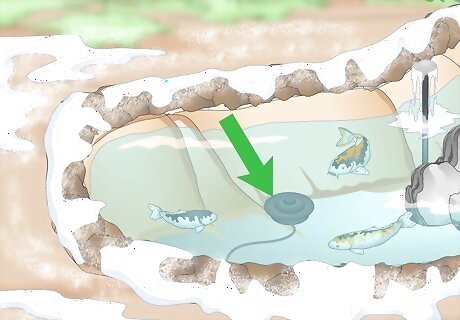
Install a pond de-icer if you expect long periods of freezing temperatures. Most coldwater fish can tolerate very low water temperatures, but they will suffocate if the surface of their pond freezes over. If you expect to have periods of freezing temperatures that last for more than a few days, install a de-icer in your pond to keep it from freezing over completely. You can buy de-icers online or from home and garden supply stores. If your area only experiences short periods of freezing weather (i.e., for a few days at a time), a good aeration pump may be enough to prevent your pond from freezing over. If your pond does freeze over, you can gently break the ice by setting a hot tea kettle on the surface until it melts through. Many species of coldwater fish, such as goldfish and koi, will hibernate over winter in the warmer pockets of water close to the bottom of the pond. They can hibernate safely in water as cold as 40 °F (4 °C).
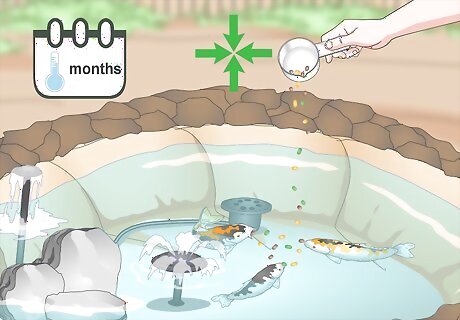
Reduce the amount of food you offer in the cooler months. Your fish will not metabolize food as quickly and easily as the water cools down, so you'll need to change your feeding pattern to suit their appetites. Once the water temperature drops below 59 °F (15 °C), feed your fish no more than once or twice a day, and offer food only if the fish act hungry. Give them no more food than they can eat in about 2 minutes. Your fish may stop eating altogether once the water temperature drops below 50 °F (10 °C). Try offering your fish a small meal twice a week, but stop if they show no interest in the food. You can buy coldwater pond pellets that are formulated to be easily digestible during the colder months.















Comments
0 comment